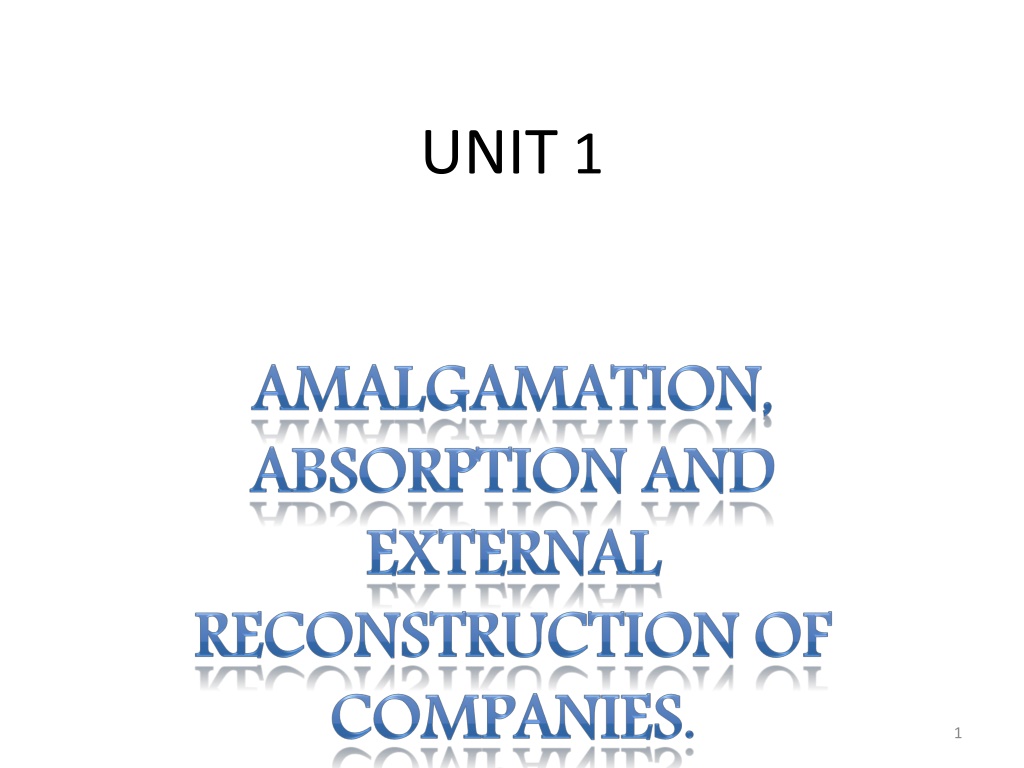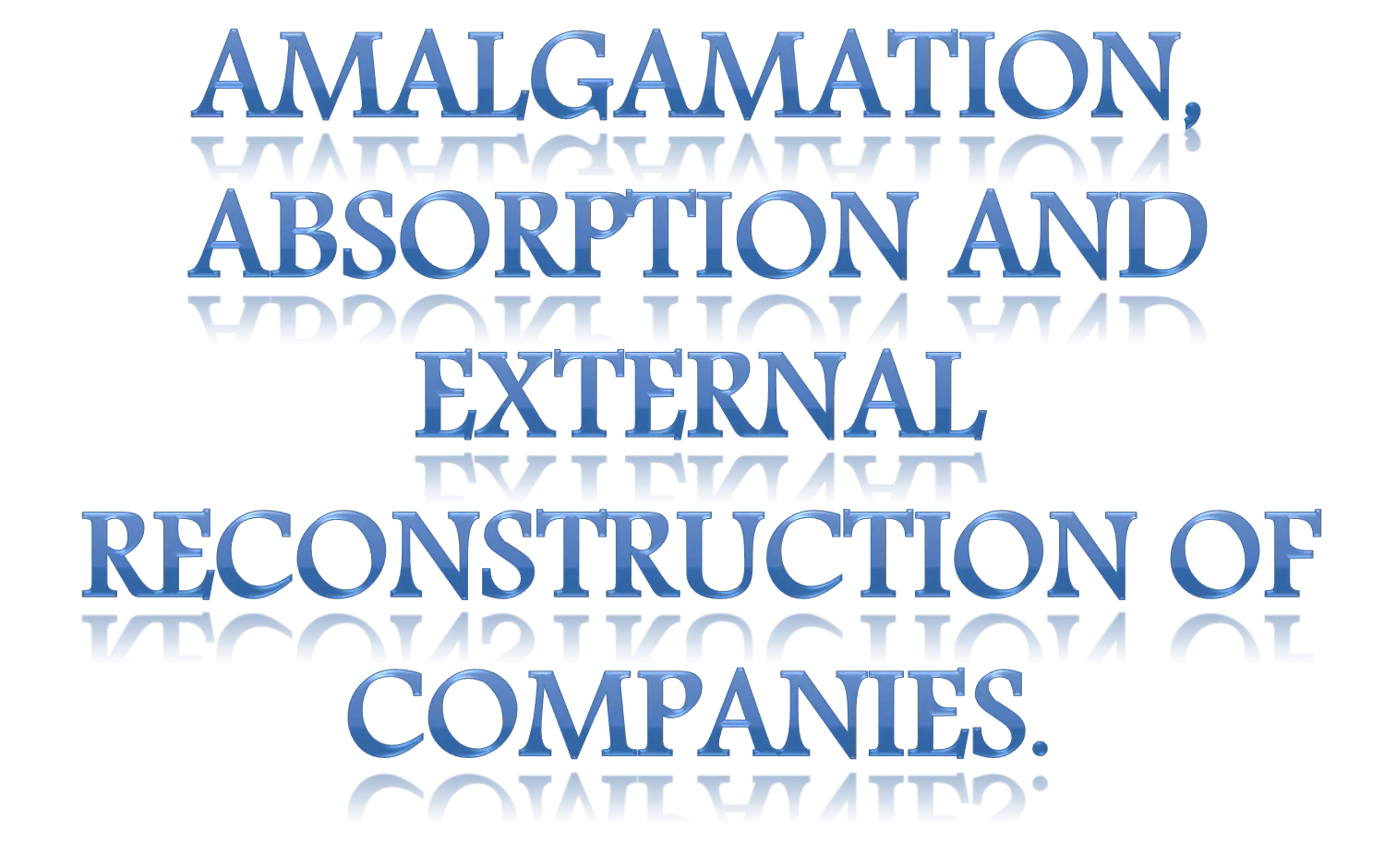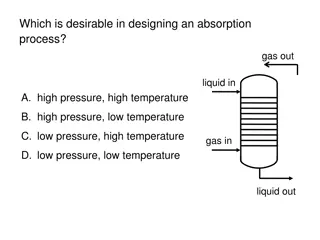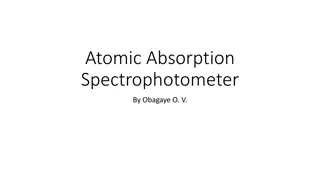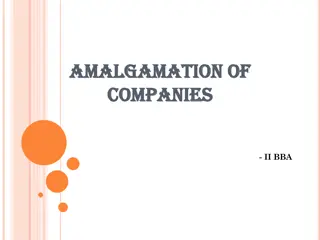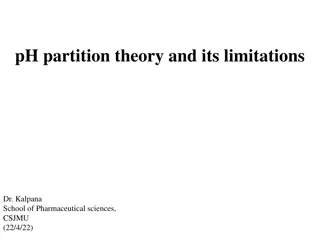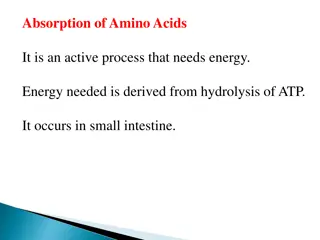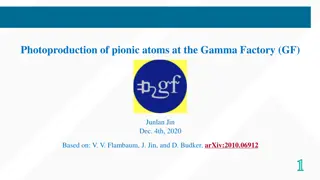Business Amalgamation, Absorption, and Reconstruction
Business combination through amalgamation, absorption, or reconstruction is a strategic move driven by competition. Amalgamation involves merging companies, absorption is one company purchasing another, and reconstruction forms a new entity. Legal provisions facilitate these processes, with vendor and vendee companies playing key roles. Various methods, such as lump sum and net assets, determine the purchase consideration in these transactions.
Download Presentation

Please find below an Image/Link to download the presentation.
The content on the website is provided AS IS for your information and personal use only. It may not be sold, licensed, or shared on other websites without obtaining consent from the author.If you encounter any issues during the download, it is possible that the publisher has removed the file from their server.
You are allowed to download the files provided on this website for personal or commercial use, subject to the condition that they are used lawfully. All files are the property of their respective owners.
The content on the website is provided AS IS for your information and personal use only. It may not be sold, licensed, or shared on other websites without obtaining consent from the author.
E N D
Presentation Transcript
UNIT 1 1
Amalgamation , absorption or reconstruction is the form of business combination. The necessity to combine two or more companies together arises out of cut-throat competition. The working expenses are reduced and the profitability is increased. Amalgamation or Absorption or Reconstruction is a form of complete consolidation. 2
Amalgamation means, the merger of two or more companies or business undertakings. Amalgamation in the business sense means, formation of a new company to acquire the assets and liabilities of two or more companies. Absorption means, purchase of a business of an existing company by some other existing company. Thus, under this form of combination, no new company is formed. External reconstruction involves formation of a new company. An existing company goes into liquidation and emerges out with a new form. 3
Sections 232, 233 and 234 of the Companies Act, 2013 facilitates amalgamation, absorption and reconstruction of companies. It provides that the liquidator of a company can accept shares, debentures in consideration of the sale of the company s undertaking to another company with an object to distribute them among the members of the transferor company provided the following two conditions are satisfied. i. A special resolution is passed by the Company. ii. The liquidator purchases the interest of any dissenting member at a price to be determined by agreement. 4
VENDOR COMPANY & VENDEE COMPANY The companies to be amalgamated, absorbed or reconstructed i.e. companies going into liquidation are termed as vendor companies, and the company purchasing or taking over business is termed as Vendee Company. 1. Purchase Consideration Purchase price payable by the purchasing company to the purchased company for taking over its assets and liabilities is called purchase consideration. Purchase price is paid generally in the form of shares, debentures of the purchasing company and cash. VENDOR COMPANY & VENDEE COMPANY 5
a) Lump sum or Direct Ascertainment Method: The price to be paid for purchase of business is stated in lump sum amount, there does not arise question of calculation. b) Net Assets Method: Net assets means total of tangible assets less total of liabilities c) Net Payment Method: In case of net payment method, all the payments received from the purchasing company either in cash or shares, debentures etc. are to be totaled up. These payments may be for Shareholders. Debenture holders or Creditors of the purchased company. Total of all such payments is the purchase price. 6
Types of Amalgamations As per Accounting Standard 14 In the nature of Purchase In the nature of Merger 7
Accounting Of Transactions In The Books Of Purchased / Vendor Company As the purchased company goes into liquidation, all the accounts are required to be closed. The following Accounts are opened: Realisation Account Purchasing company s Account Debenture holders Account Preference Shareholders Account Equity Shareholders Account 8
Steps in the books of Vendor Co. 1) 2) 3) 4) 5) 6) Transfer assets taken over to Realisation Transfer liabilities taken over to Realisation PC Due PC Received Transfer Pref. Share capital to Preference Shareholders A/c Transfer funds belonging to equity shareholders to Equity Shareholders A/c (Reserves, P & L A/c, Share Premium, Miscellaneous Expenses etc.) Sale of the assets not taken over Payment of the liabilities not taken over Realisation expenses 10) Payment to Preference Shareholders 11) Realisation profit or loss Equity Shareholders 12) Payment to Equity Shareholders 7) 8) 9) 9
ACCOUNTING ENTRIES Following Journal Entries are passed to close various accounts in the books of the purchased company or company going into liquidation. Realisation Account 1) Assets Account: All assets except cash and bank are transferred to Realisation A/c by passing the entry Realisation A/c Dr. To Assets A/c [ Except Fictitious Assets] Cash /Bank balance is also transferred to Realisation A/c only if it is taken over by the purchasing co. 10
ii. Liabilities 2) Liabilities taken over by the Purchasing Company are transferred to Realisation A/c Liabilities A/c Dr. To Realisation A/c 8) Liabilities not taken over by the Purchasing Co. Liabilities A/c Dr. To Cash/Bank A/c Or To Shares in Purchasing Company A/c The profit or loss resulting from such payment is transferred to Realisation Account 11
c) Liabilities outside the Balance Sheet If there arise any new liability, which is not included in the Balance Sheet, the treatment is given as under. If it is taken over by the Purchasing (Vendee)Co. no entry is to be passed in the books of the Purchased Co. The Purchasing Company (Vendee) will record it in its own books along with the other liabilities taken over. If it is to be paid by the Purchased Company (Vendor), the entry will be Realisation A/c Dr. To Cash/Bank A/c 12
d) Contingent Liabilities i. Cancellation of Contingent Liabilities. No entry is to be passed in the books of any company. ii. Contingent liability turns into actual liability. a) If it is taken over by the Purchasing Company no entry is to be passed in the books of Purchased Company. The Purchasing Company will record it along with other liabilities. b) If it is to be paid by the Purchased Company, the entry will be Realisation A/c Dr. To Cash/Bank A/c 13
If the debentureholders or Preference Shareholders of the purchased company are to be repaid at premium or discount, the amount of premium is debited to Realisation A/c, whereas the amount of discount is credited to Realisation A/c as- Realisation A/c Dr. To Debentureholders A/c To Preference Shareholders A/c (For Premium Payable) OR Debentureholders A/c Dr. Preference Shareholders A/c Dr. To Realisation A/c (For the Amount Of Discount) 14
3) Purchase Price is to be paid Purchasing Company s A/c Dr. To Realisation A/c 9)Realisation or Liquidation Expenses i. If they are paid by the purchased company itself Realisation A/c Dr. To Cash/Bank A/c ii. If they are to be paid by the Purchasing Company and a) The amount is included in the purchase consideration. Realisation A/c Dr. To Cash/Bank A/c b) The amount is not included in the purchase consideration and the expenses are being paid separately by the Purchasing Company itself. No entry for payment of expenses is to be passed in the books of Purchased Company 15
7) If any asset is not taken over by the Purchasing Company and it is sold off by the liquidator of Purchased Company- Cash/Bank A/c Dr. Realisation A/c (loss) Dr. To Asset A/c To Realisation A/c (Profit) 11) Profit or Loss on Realisation : It is transferred to Equity Shareholders A/c. Realisation A/c Dr. To Equity Shareholders A/c (for transfer of Realisation Profit) OR Equity Shareholders A/c Dr. To Realisation A/c (for transfer of loss on Realisation) 16
2.Purchasing Companies A/c On receipt of purchase price the Purchasing Company s A/c is credited with the receipt and its Account is closed by passing the following entry. 4) Receipt of Purchase Consideration : On receipt of shares, debentures, cash etc from the Purchasing Co., in settlement of purchase price, these items are debited and the Purchase Company s A/c is credited i.e., Equity Share A/c Dr. Debentures A/c Dr. Preference Shares A/c Dr. Cash/Bank A/c Dr. To Purchasing Company s A/c 17
3.Debentures of the Purchased Co. If the debentures of purchased company are to be discharged by the purchasing company itself the entry in the books of purchased company is passed as under with their face value : Debentures A/c Dr. To Realisation A/c Debentureholders A/c is closed by debiting their Account with Shares, Debentures or Cash given to them in payment of their claim. Generally, the debentures received from the Purchasing Company, are given to these debentureholders in which case the entry is passed Debentureholders A/c Dr. To Debentures To Cash/Bank A/c 18
If the purchased company receives price for the discharge of debentures and the purchased company has to repay them, the following entries are passed in the books of purchased company a)To transfer balance on Debentures A/c to Debentureholders A/c Debentures A/c Dr. To Debentureholders A/c b) If they are to be paid at premium, the following entry is passed for the amount of premium. Realisation A/c Dr. To Debentureholders A/c And if they are to be repaid at discount, Debentureholders A/c Dr. To Realisation A/c 19
5) The balance on Preference Share Capital A/c is transferred to Preference Shareholders A/c and the Capital A/c is closed Preference Share Capital A/c Dr. To Preference Shareholders A/c 10) The Preference Shareholders A/c is closed by giving them shares of Purchasing Co. or cash Preference Shareholders A/c Dr. To Shares A/c To Cash/Bank A/c 20
5.Equity Share Capital and Accumulated Profits and Losses 6) A)Equity Share Capital A/c Dr. Share Premium A/c Dr. Forfeited Shares A/c Dr. Debenture Redemption Fund A/c Dr. To Equity Shareholders A/c 6) b)All the loss items are debited to Equity Shareholder as- Equity Shareholders A/c Dr. To Profit And Loss A/c To Preliminary Expenses A/c 5.Equity Share Capital and Accumulated Profits and Losses 21
6. Equity Shareholders A/c 12)Equity shareholders a/c is closed by giving the Equity Shareholders whatever assets in the form of shares, debentures, cash are remaining with the Purchased Company after payment of all other liabilities . The entry is Equity Shareholders A/c Dr. To Shares A/c To Debentures A/c To Cash/Bank A/c Thus all the accounts in the books of Purchased company are closed. 22
In the books of Vendee Company Business Purchase Recording Assets & Liabilities Purchase Consideration Paid Other Entries like Realization Expenses, Liabilities Paid Off 23
Journal Entries In the books of Vendee Co Sr. No. In the nature of Merger In the nature of Purchase 1. Business Purchase A/c Dr. To Liquidator of Vendor Co. Business Purchase A/c Dr. To Liquidator of Vendor Co. 2. Assets A/c Dr. (Agreed value) Prel. Expenses A/c Dr. Goodwill A/c Dr. (Balancing Fig) To Liabilities A/c (Agreed value) To Capital Reserve To Business Purchase A/c To Profit & Loss A/c To General Reserve (Bal) Assets A/c Dr. (Agreed value) Prel. Expenses A/c Dr. Goodwill A/c Dr. (Balancing Fig) To Liabilities A/c (Agreed value) To Business Purchase A/c To Capital Reserve (Balancing Figure) 3. Liquidator of Vendor Co. A/c Dr. To Equity Share Capital To Pref. Share capital To Share Premium A/c To Debentures A/c To Cash / Bank A/c Liquidator of Vendor Co. A/c Dr. To Equity Share Capital To Pref. Share capital To Share Premium A/c To Debentures A/c To Cash / Bank A/c 24
Journal Entries In the books of Vendee Co Sr. No. In the nature of Merger In the nature of Purchase 4. No Entry Statutory Reserves A/c Dr. To Amalgamation Adjustment A/c 5 Goodwill / General Reserve A/c To Cash / Bank (Realisation Expenses) Goodwill / Capital Reserve A/c To Cash / Bank (Realisation Expenses) 25
